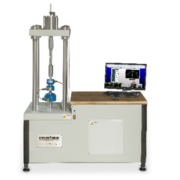Detailing Sensor Rated Output Millivolts Per Volt
 In force measurement, many sensor and instrument specifications need careful examination to ensure you get the right solution for your testing project.
In force measurement, many sensor and instrument specifications need careful examination to ensure you get the right solution for your testing project.
We strongly advise reviewing the electrical specifications meticulously outlined on every Interface load cell, multi-axis sensor, and reaction torque transducer datasheet. This comprehensive understanding of rated output (RO), excitation voltage, bridge resistance, zero balance, and insulation resistance will enable you to select the appropriate sensor for your testing project.
Rated output is expressed using the specifications millivolts per volt (mV/V). This is the electrical output of a load cell, multi-axis sensor, or reaction torque transducer in mV/V of excitation at the rated load. It essentially expresses a load cell’s sensitivity. RO represents the change in output voltage in millivolts of the load cell relative to a change in the excitation voltage in volts applied to it.
For example, the electrical voltage output of an Interface load cell with 4 mV/V at 5,000 lbf rated capacity will typically be characterized as 4 mV ± 10% or 3.6 mV/V to 4.4 mV/V. Depending on the application, a tighter output tolerance may be needed. Find more examples in our free Interface Load Cell Field Guide.
Before delving into the significance of mV/V in load cell specifications, let’s grasp a few electrical specification terms. These terms, such as rated output, excitation voltage, and nonlinearity, are not just technical jargon. They directly impact the performance of your load cell. By understanding mV/V and other technical aspects of load cell design, you can select the load cell that best suits your application, ensuring precise and accurate force measurements.
- Rated Output: The output corresponding to capacity equals the algebraic difference between the signal at (minimum load + capacity) and the signal at minimum load. This specifies the maximum output voltage the load cell produces at full capacity.
- Excitation Voltage: Load sensors contact a full bridge circuit. Each leg is usually 350 ohms, except Interface’s 1500 models are 700 ohms. The preferred excitation voltage is 10 VDC, which guarantees the closest match to the original calibration performed at the Interface calibration lab. The voltage supplied to the load sensor powers its internal strain gages.
- Nonlinearity: The algebraic difference between output at a specific load and the corresponding point on the straight line between minimum and maximum loads. Normally, it is expressed in units of %FS. It is common for characterization to be measured at 40-60 %FS. The relationship between applied force and output voltage may not be linear, especially at high or low forces. The load cell’s specifications will usually detail its non-linearity.
Follow our Interface 101 Series for extensive coverage of key specifications, products, technical topics, and sensor basics.
Why mV/V Matters
- Relates Force to Electrical Signal: The mV/V rating helps you understand how much force is required to generate a specific voltage output. A higher mV/V rating indicates a more sensitive load cell, producing a larger voltage change for a smaller applied force.
- Calibration and Accuracy: Since mV/V is a ratiometric measurement, it minimizes errors caused by fluctuations in the excitation voltage. This is because the output voltage changes proportionally with the excitation voltage. Many instruments can handle ratiometric measurements, leading to more accurate readings.
- Choosing the Right Load Sensor: When selecting a load sensor, consider your desired level of sensitivity. A higher mV/V rating is preferable for high-precision measurements of small forces. However, a lower mV/V might be sufficient for heavy-duty applications with high forces.
TIP: Interface can standardize the outputs within ±0.1% of the rated outputs shown on the product specification datasheet. This would look like 4 mV/V output standardize to 3.996 mV/V to 4.004 mV/V).
Understanding electrical specifications like mV/V will ensure you select the right solution for your application. Tune into our Demystifying Specifications Complete Webinar. We encourage you to contact us if you have additional questions about mV/V or any other electric specifications on our product specification sheets.
ADDITIONAL RESOURCES
Load Cell 101 and What You Need to Know
Load Cell Basics Sensor Specifications
How Do You Know if Your Load Cell Needs Calibration Service or Repair?








